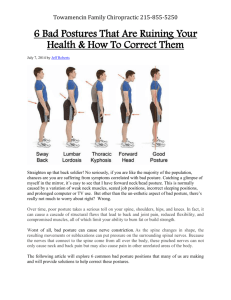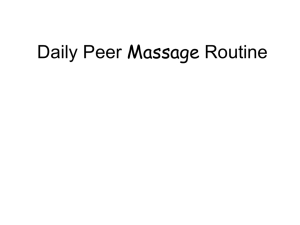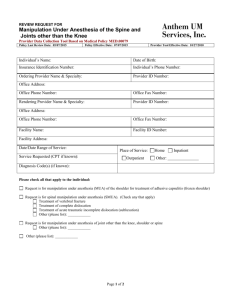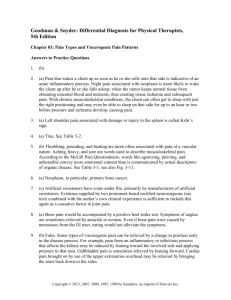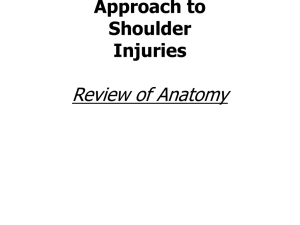7 safe exercises - St. Louis City Fitness
advertisement
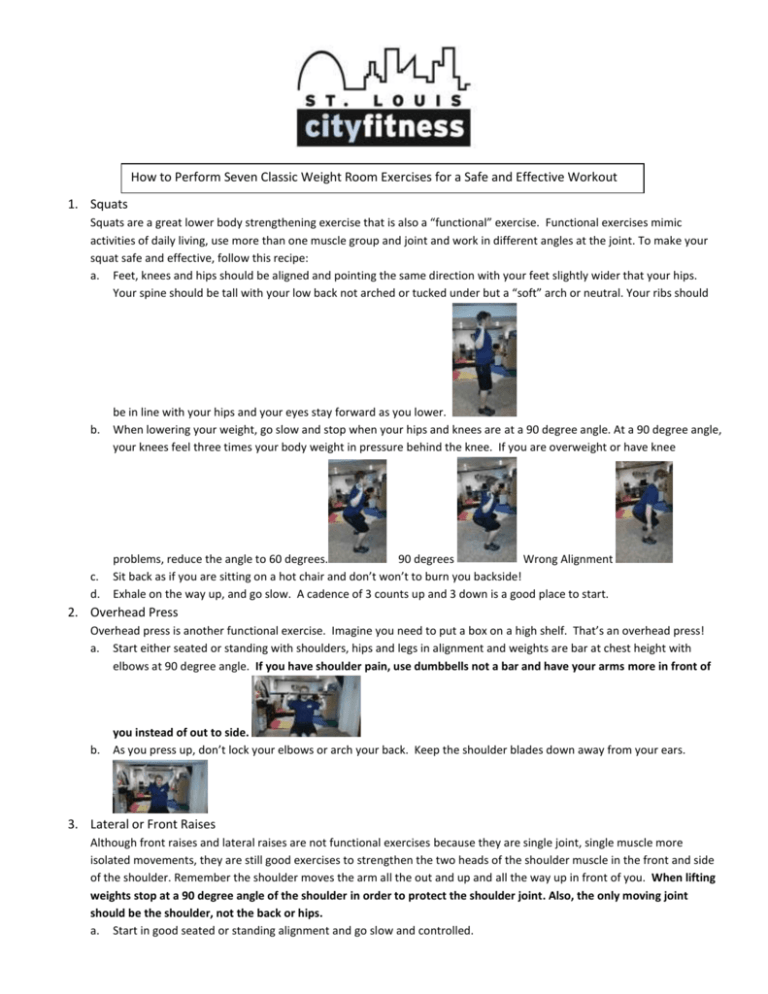
How to Perform Seven Classic Weight Room Exercises for a Safe and Effective Workout 1. Squats Squats are a great lower body strengthening exercise that is also a “functional” exercise. Functional exercises mimic activities of daily living, use more than one muscle group and joint and work in different angles at the joint. To make your squat safe and effective, follow this recipe: a. Feet, knees and hips should be aligned and pointing the same direction with your feet slightly wider that your hips. Your spine should be tall with your low back not arched or tucked under but a “soft” arch or neutral. Your ribs should b. c. d. be in line with your hips and your eyes stay forward as you lower. When lowering your weight, go slow and stop when your hips and knees are at a 90 degree angle. At a 90 degree angle, your knees feel three times your body weight in pressure behind the knee. If you are overweight or have knee problems, reduce the angle to 60 degrees. 90 degrees Wrong Alignment Sit back as if you are sitting on a hot chair and don’t won’t to burn you backside! Exhale on the way up, and go slow. A cadence of 3 counts up and 3 down is a good place to start. 2. Overhead Press Overhead press is another functional exercise. Imagine you need to put a box on a high shelf. That’s an overhead press! a. Start either seated or standing with shoulders, hips and legs in alignment and weights are bar at chest height with elbows at 90 degree angle. If you have shoulder pain, use dumbbells not a bar and have your arms more in front of b. you instead of out to side. As you press up, don’t lock your elbows or arch your back. Keep the shoulder blades down away from your ears. 3. Lateral or Front Raises Although front raises and lateral raises are not functional exercises because they are single joint, single muscle more isolated movements, they are still good exercises to strengthen the two heads of the shoulder muscle in the front and side of the shoulder. Remember the shoulder moves the arm all the out and up and all the way up in front of you. When lifting weights stop at a 90 degree angle of the shoulder in order to protect the shoulder joint. Also, the only moving joint should be the shoulder, not the back or hips. a. Start in good seated or standing alignment and go slow and controlled. b. Good Form Front Raise 4. Push ups Bad Form Front Raise Push ups are one of the best body weight resistance exercises you can perform for all of the major muscle groups of the upper body including arm muscles, shoulder muscles and chest muscles. In addition, it is was we call a “core” exercise which challenges the muscles around your shoulder girdle, hip girdle and spine to “stabilize”. Stabilization is when the muscles contract to support the joint but don’t actually change length or change the angle of the joint. The correct form and alignment of a push up is the same if you do them on your hands and toes or hand and knees. a. Start position is up with arms slightly wider than your shoulders, elbows extended but not locked, back in line with hips, shoulder blades down and flat on the back, hips in line with shoulders not hiked up and head in line with the spine. b. As you move down slowly for 3 counts inhale. At the bottom of the push up, your elbows should be in no more than a 90 degree angle to protect the shoulder, spine should not be swayed or rounded and your shoulder blades should be flat on your back and not “pinched” together. 5. Lunges Just like squats, lunges are a functional, mutli-joint, mult-muscle exercise that strengthens all the muscles around the knees, hips and ankles. Also, the lunge provides an opportunity for “dynamic” balance training. When you stand on one leg and try to balance it is static balance training. When you move in a direction on one leg it is dynamic balance training. Life is full of dynamic balance challenges in which the body is moving and trying to balance. a. Start with chest, spine and hips in alignment, head up and feet hip distance apart. b. Depending on if you are going to step forward or backward into the lunge, the safe alignment at the bottom is the same. The weight should be 60 percent on the front leg, the hips should not drop below the knees and the front knee should be at no more than a 90 degree angle. Your upper body should be over your pelvis and not “falling” forward over your knee. Also, your eyes should be forward and your head should be in line with your spine. c. Good Lunge Alignment 6. Lat Pulldowns Bad Lunge Alignment The latissimus muscle on your back is a very large surface back muscle that moves your arms back and towards the center of your body. Therefore, the “Lat Pulldown” is the perfect exercise to challenge the muscle. Although this is a great weight room exercise, it is usually done wrong and can cause back and shoulder pain if done incorrectly. Also, you don’t need a pully cable to perform it. You can use resistance tubing with or without a bar. a. If you wish to perform an easier version where the muscles supporting the front and back of the body don’t have to stabilize, perform the exercise seated more upright. b. If you wish to challenge your ab and back stabilizers, perform the exercise in a hip hinged position with your back c. straight and neck neutral. In either position, keep the head in line with the spine and lead the movement with the pulling of the shoulder blades back and down the spine, then bend the elbows using your biceps. 7. Abdominal Curls We all talk about the “six pack” but strong abdominals have nothing to do with a six pack. We have 4 layers of abdominal mucsles and the deepest level are the most important for supporting us and keeping our back healthy and pain free. When we curl our spine and keep our pelvis neutral and low back gently pressed into the floor, we better utilize the deepest abdominal muscle, the transverse. Also, exhale forcefully through your mouth almost like a “cough” as you curl your spine and you will better activate this muscle. a. Start on your back, knees bent, feet hip distance apart, head in line with spine and your low back “gently” resting on the floor or with minimal space between your low back and the floor. If you have a history of back pain or really weak b. c. abdominals, start with your legs elevated in order to keep your low back neutral. As you curl up, remember your abdominal muscles start at the top of your ribs and stop at your pubic bone. So, lift from your ribs not your neck. Also, the farther your hands are away from the center of your body(belly button), the more difficult the movement. So, to make is easier, put your arms close to your body as pictured. Curl up only as far as you can go and not lift your body and arch your low back. Bad Form for Curl UP Also, try to keep your head in alignment with the spine to protect your neck. Poor Neck Alignment For more information on corrective exercise or exercise programming for a safe effective workout, our trainers are available for 30 or 60 minute personal training sessions at your convience. In addition, proper technique and alignment is taught in all of the classes at the Federal Reserve Bank. Come try a class today! St Louis City Fitness LLC offers personal training, group classes, pilates and gyrotonic training in the St Louis Metropolitan area at our studio at 7700 Clayton Road, Suite 100, St Louis 63143 and at corporate sites in the surrounding area. For more information about our company please visit our website at saintlouiscityfitness.com or contact us at 314-276-6694 or 314-322-9928.
